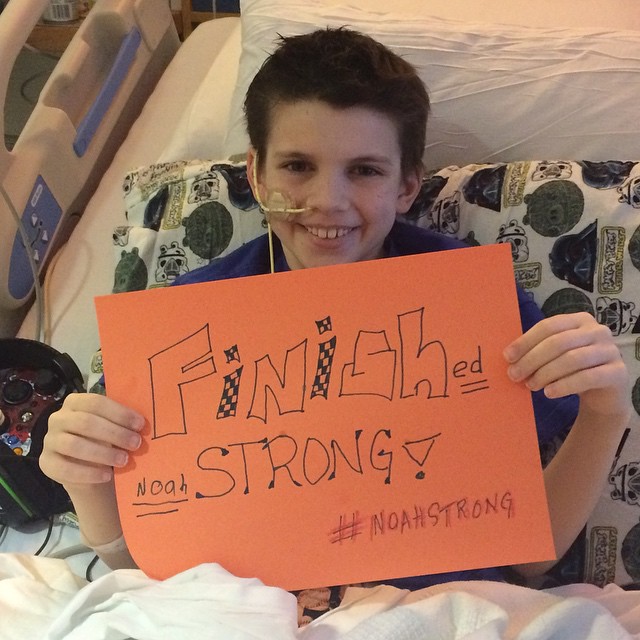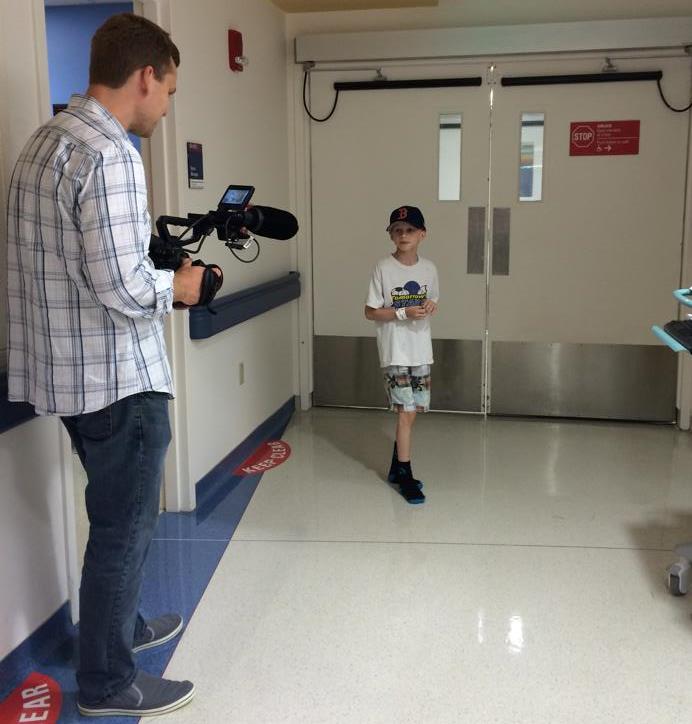
Before he was diagnosed with neuroblastoma in 2014 at the age of 11, Noah Smith was a veteran of the children’s theater stage. The suburban Boston boy had been cast in ensembles. He’d played Kurt Von Trapp in “The Sound of Music.”
Little did Noah know that he would soon star in a video designed to allay the fears of children with high-risk neuroblastoma facing radioactive medication delivered intravenously in a lead-lined room where they’d live, under restrictions, for a week. After he received the medication, his parents would only be able to visit him one at a time, standing behind a lead shield and unable to touch him. Nurses would also limit their time in his room, entering briefly to check vital signs. Parents and nurses alike would wear badges to monitor their exposure to the radioactive child in the bed.

Add to this the fact that most children who get this cancer that originates in nerve cells are under 5, and it’s easy to understand the anxiety that these young patients – and their families – might feel anticipating MIBG (metaiodobenzylguanidine) therapy.
Even Noah’s parents were nervous, despite the added maturity he had as an unusually old neuroblastoma patient. By the time he had MIBG in June 2014, Noah had already undergone chemotherapy and surgery at Dana-Farber/Boston Children’s Cancer and Blood Disorders Center. After MIBG, Noah had a stem cell transplant, external beam radiation, and, finally, antibody immunotherapy and a second surgery.
“When they presented MIBG as an option, it was one of the more terrifying choices,” Noah’s mother, Christine Smith, recalls. “They’re going to put your kid in an isolated, lead-lined room. You can’t go in and snuggle in bed. Instead you’re sitting in a room outside. Am I going to feel helpless? Is this going to traumatize him? Will he feel abandoned being left alone? I struggled with that. At the end of the day, you’re faced with the reality of spending a week undergoing MIBG and hoping for the best, or opting out of something that could save your son’s life.”
This is precisely the kind of stress that Jennifer Spidle, a nurse practitioner at Dana-Farber/Boston Children’s, hoped to ease with a child-friendly video about what to expect with MIBG. And what better narrator to enlist than a personable 11-year-old patient? That Noah was also an experienced actor was an unexpected bonus.

Originally developed as a blood pressure medication, MIBG is a compound that is absorbed by certain types of nerve tissue, including neuroblastoma cells. It has long been employed as a diagnostic tool to pinpoint neuroblastoma cells in the body. More recently, oncologists began using it to deliver targeted radiation to neuroblastoma. Dana-Farber/Boston Children’s was the first hospital in New England to offer MIBG and is one of only about 10 institutions in the country with the therapy.
“I wanted to do the video because I wanted to let other kids know it wasn’t so bad,” Noah says. “At first MIBG was scary, but it went by pretty fast. The medicine makes you kind of sleepy so you sleep a lot. Or else I was using the gaming console or watching YouTube on my iPad. And it didn’t make me nauseous. The time goes by really fast, so you don’t notice how long you’re by yourself.”
Read More:
In the video, Noah is a confident and upbeat guide, explaining the procedure, showing off the toy- and game-filled MIBG room, and reassuring patients. “At first I was kind of nervous, but I really was OK,” he says as the video opens. “There are a few rules that you and your family will need to follow while you’re in the hospital. But don’t worry, they’re easy. … Even though you have to stay in bed, you get lots of toys, games, and other fun things to do.”
For clinicians at Dana-Farber/Boston Children’s who field inquiries about MIBG from around the country and the world, the video has proved an effective tool to explain the complex therapy. “Parents and family can have a look even before their first consult,” Spidle says. “Letting them see MIBG through a child’s eyes has been a really positive thing.”
Meanwhile, Noah finished treatment in June 2015. A few weeks later he played Michael in “Peter Pan” at Steps Off Broadway in Bellingham, Massachusetts.
“It was really fun,” Noah says. “Just being able to get back onstage and do something I enjoy. And I got to fly.”
Learn more about MIBG therapy and neuroblastoma treatment at Dana-Farber/Boston Children’s.
